Hello,
I need to analyse a number of polygons which represent buildings, the data i need is the inner corner of every point and the length of every segment. I'm using the polylineanalyzer to get this data and this works as long as the polygon is a solitary object. If another polygon is adjacent to the one being examined it seems that the common lines are being kept out of the examination in the polylineanalyzer. The number of lines which flow out of the polylineanalyzer are less than the total number of polygonsegments.
Has anyone an idea how to bypass this?
best regards & thanks







